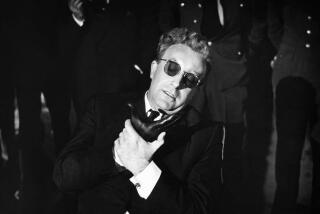FILM : Still Packs a Wallop in Post-Cold War Era
- Share via
Stanley Kubrick has never been a director to hold much back. From his apprentice days stirring potboilers like “Killer’s Kiss” to the violent sensationalism of “A Clockwork Orange,” Kubrick’s played rough and tumble with the rules of establishment movie-making.
Even those who don’t like all his work (at his worst, he can be sort of a highbrow Ken Russell) agree that by aggressively stretching the limits, he’s helped spur the evolution of film. Besides his creative use of the camera and music, almost secondary languages in his movies, Kubrick’s one of the few directors to set new standards through the risky content of his projects.
In arguably his greatest--and certainly his funniest--movie, “Dr. Strangelove, or How I Learned to Stop Worrying and Love the Bomb” (screening at the Wilshire Auditorium in Fullerton tomorrow), Kubrick put niceties aside to created what is still one of the most pungent black comedies. Making a thinking man’s “Road Runner” cartoon of nuclear war (and getting us to laugh along) was no minor trick, but he accomplished it brilliantly in this uncompromising satire.
From the opening credits of “Dr. Strangelove,” you know there’s nothing traditional about Kubrick’s point of view (or that of co-writers Terry Southern and Peter George). While mushy romantic music bubbles up, we see two bombers refueling in the clouds. It looks like they’re copulating, a foreshadowing of one of the movie’s funny-incisive themes: the link between sex and aggression.
Gen. Jack Ripper (Sterling Hayden in a wonderful teeth-clenching performance) takes the screen soon after, and we learn that he has unilaterally sent a squad of B-52s to bomb the Soviet Union. He’s a loon, babbling to his aide (one of Peter Sellers’ three roles) about a communist plot to ruin our “bodily fluids” through fluoridation.
This kicks off a rash of misadventures as the President (Sellers again) and his gang of Cabinet members and generals evaluate the options and try to prevent a holocaust. The remarkable thing about “Dr. Strangelove” is how none of it is ever grim--it makes you howl at the most chilling possibilities.
Everyone has his or her favorite characters. George C. Scott is the general who takes calls in the War Room from his bimbo girlfriend and argues madly for an all-out strike. Sellers’ wishy-washy President and the Soviet premier bicker about who’s most disturbed by this turn of events.
And then there’s Sellers’ Dr. Strangelove creation, the maniacal German scientist supposedly mocking Werner von Braun (these days, though, Henry Kissinger is more apt). With his Liberace hair, uncooperative right arm (it rips cigarettes out of his mouth and tries to throttle him) and choking voice, he’s a picture of pure dementia as he explains how the United States can survive radiation fallout by dropping all high government officials into deep mine shafts with 10 “breeding females” each.
A special place in movie folklore is also reserved for Slim Pickens as the plain-spoken bomber pilot who is last seen bronco-busting a missile as it sails down toward its Soviet target. Yee-haw!
Made in 1964, “Dr. Strangelove” didn’t follow the Cuban Missile Crisis by all that much and was unjustly criticized for trivializing that desperate event and the possibility of a nuclear confrontation. And now, with the Gulf War at full pace, it’s likely that any viewing will bring a certain edginess. That’s what happens when irony becomes a weapon for insight.
What: Stanley Kubrick’s “Dr. Strangelove.”
When: Friday, Feb. 22, at 7:30 p.m.
Where: The Wilshire Auditorium, 330 N. Lemon St., Fullerton.
Whereabouts: Take the Riverside (91) Freeway to Lemon Street and head north.
Wherewithal: $4 and $5.
Where to Call: (714) 871-4030, Ext. 15.
More to Read
Only good movies
Get the Indie Focus newsletter, Mark Olsen's weekly guide to the world of cinema.
You may occasionally receive promotional content from the Los Angeles Times.







